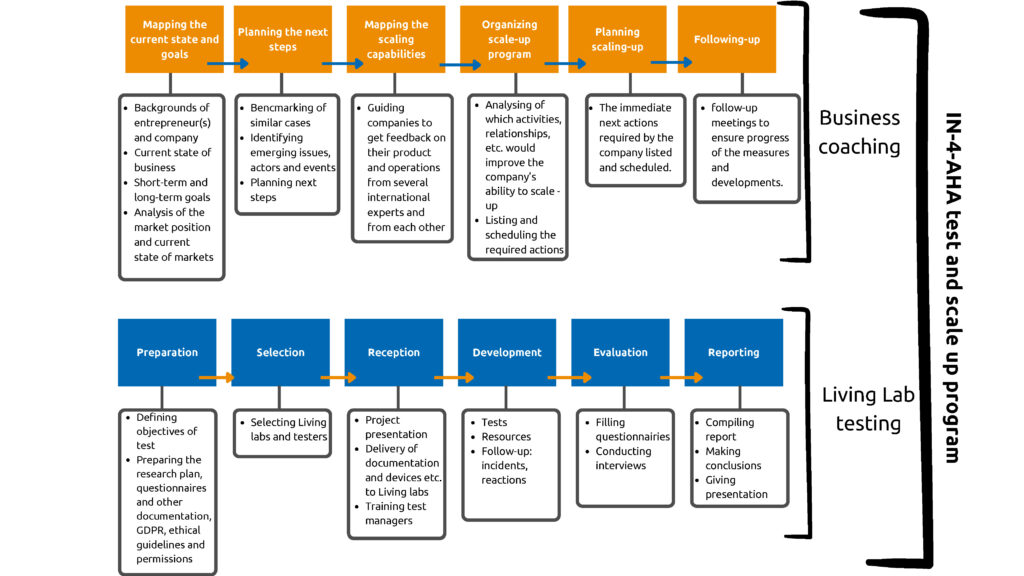
What is a Living Lab?
Living labs are real-life (resembling) environments (“living”), where innovation experts develop and test innovations together with users (“lab”). Important elements in living labs include multi-stakeholder participation and a multi-method approach.
One of the main objectives of living labs is to minimise the innovation risk and maximise the likelihood of successful market entry. For AHA innovations, using this opportunity to test ideas and solutions is particularly important because the health and care systems, practices and legislation are different in each EU country.
Read more about living labs and similar environments from the complete version of the playbook (pages 16-19).
Preparations for Living Lab tests
- The purpose of testing is to learn new things and, based on what has been learned, continue the development work in a slightly different direction, then test again. It is better to start small and keep things simple.
- It is good to keep in mind that the co-design process is a market-specific process. It may be necessary to start from an earlier development phase in a new market environment.
- Each living lab is different. Not all living labs have the same facilities and resources, and therefore it may be necessary to make some compromises to match the living lab’s resources, facilities and networks with the demands of the innovator.
The table below illustrates some types of tests that can be carried out in AHA living labs based on tests for pilot companies in the IN-4-AHA Project.
Solution | Target group | Living Labs | Tests |
|---|---|---|---|
Operating concept for tablets that facilitates independent digital communication for beginners | • Professionals with sufficient knowledge in the use of technological tools
• Senior people (65+), include members of both genders, and have little or no experience with digital applications.
| • Day care centre
• Continuing education centre for the elderly
• Associations for the elderly and their relatives
| End-user tests where information was collected regarding end-users’ understanding, reactions and attitudes towards the device |
A virtual assistant for active ageing designed for people with neurodegenerative mental illnesses. | • Health professionals with knowledge in the use of technological tools.
• Senior people (65+) with varying degrees of cognitive impairment (Parkinson’s disease, Alzheimer’s or another dementia)
| • Nursing home
• Home care services
• Day care centre
• Associations for the elderly and their relatives
| End-user tests by seniors and health professionals to co-create an enabling environment with end-users, so that solution can be validated in an everyday environment.
|
A software solution that integrates menus with user information for healthy eating. | • Nutrition team professionals
• Professionals of the nursing team
• Professionals in the kitchen team
• Innovation team professionals
| • Nursing home
• Day care centre
• Hospital
| • Participatory design workshop for the company and end-users
• End-user tests where the behaviour and reactions in the user experience of the professionals who were testing the application were observed.
|
Examples of typical tests, based on tests carried out for IN-4-AHA pilot companies
Living Lab testing process
Living Labs can conduct tests in different phases of the innovation process, but the tests differ depending on the phase in which the solution is in, and the market in question. Methods can include, for example, focus groups, interviews, questionnaires, usability testing or lead user innovation.
Before the living lab process starts, innovators must be able to define their aims, needs, and expectations for the living lab testing: what is being tested, why is it being tested, what is the desired learning outcome, who (which groups) is testing the solution, which tests/methods will be used, and how and where are the tests carried out.
The following tools offer examples of issues innovators should consider before living lab tests.
(> Tool 1) and (> Tool 2)
Tests conducted in the IN-4-AHA project for the pilot companies showed that the higher the degree of person-centred care (PCC) present in the technological innovations, the higher the level of adoption by the end-user. This tool helps to estimate the PCC values. (> Tool 3)
This tool describes Technology Readiness Levels (TRLs) and provides checklists to determine if the technology is at that specific TRL. (> Tool 4)
A typical living lab testing process consists of preparation, selection, reception, development, evaluation, and reporting phases described in the figure below. The figure also illustrates how the living lab testing process was integrated with the coaching process in the IN-4-AHA project.
Services of Living Labs
Besides testing, living labs may offer a wide range of services:
- Project planning and management services aim to support the planning and implementation of the user-centric living lab innovation process.
- Equipment and facility rental services aims to ensure that the required equipment, labs and other facilities are available for living lab testing and development activities.
- Business support services aim to support the business activities related to the solutions being tested and developed at a living lab.
Special issues
Special issues to consider in living lab tests include ethical issues, medical device regulations and CE marking, data protection and intellectual property rights. Please read more from the complete version of the playbook (pages 32-35) here.
How to build a Living Lab?
Advice for organisations planning to start a living lab is given in the complete version of the playbook (pages 35-38) here.
